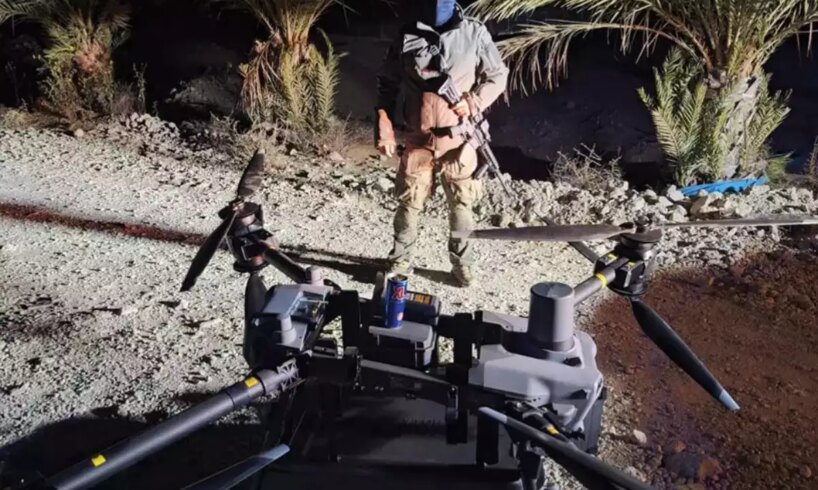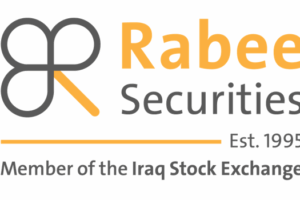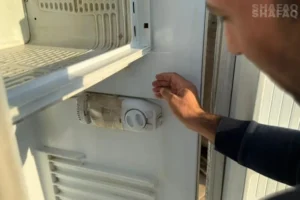
Since the horrors of the October 7 massacre and the ensuing war, the threat posed by drones has seared itself into Israel’s collective consciousness. But this threat is no longer limited to Gaza or to Israel’s northern borders. The Israel-Egypt border, stretching some 200 kilometers (124 miles), is both long and vulnerable.
Despite the peace treaty between the two countries, which creates a sense of deceptive calm, the region has become a hotspot for increasingly sophisticated cross-border smuggling operations.
What began as drug and animal smuggling by vehicle, has evolved into an advanced network of aerial contraband. In recent years, influenced by the war in Gaza and advances in technology, smugglers have shifted to using drones. The method is simpler, more efficient, and far harder to detect.
The border with Egypt is a major smuggling route (Archive). Photo: IDF Spokesperson
From drugs to weapons
While the smuggling of drugs and livestock has been ongoing for years, the recent influx of heavy weapons marks a deeply troubling shift. According to testimony presented at a Knesset Foreign Affairs and Defense Committee emergency session, there were 10 to 15 smuggling incidents every night in 2024. Though the current figures are classified, they are believed to be higher.
During the Rosh Hashanah holiday alone, 500 drones reportedly crossed into Israeli territory in just three days, according to a security officer from Kadesh Barnea. Alarmingly, the IDF is estimated to intercept less than 10% of drones. While the phenomenon initially occurred mostly at night, these drones have recently been spotted operating in broad daylight.
The smuggling system relies on coordination between organized crime families, with some based in Sinai, while others are based in Israel. Drones are flown empty from Israel into Egypt, then return loaded with weapons or drugs. The profit margin is enormous: smuggling four MAG machine guns can yield up to 1 million Shekels (about $300,000), while 30 kilograms (66 pounds) of drugs can fetch even more. The risk is considered worth the reward.
The technology has also evolved. Older GPS-based drones, like the “Snipes,” were relatively easy for the IDF to neutralize. But as the military adapted, smugglers moved on to more advanced models, such as “Matrix” drones, and now operate with devices that don’t rely on GPS, complicating Israeli countermeasures. In response, the IDF is intensifying efforts to upgrade its border surveillance and interception technologies.
“They are sophisticated,” said Yehuda Kapach, southern coordinator for the Regavim movement. “They know when enforcement is strong and when it isn’t. When a new system is deployed by the army, they lay low until it’s deactivated or moved, then resume.”
Cat and mouse
Residents on the border say the situation is dire. “We see the drones above us, we hear the buzzing,” said Eyal Ben, a member of a rapid response team from a community near Nitzana. “Just recently, I saw a drone cross the border five times in one hour. Most of these carry weapons. This must be treated as terrorism. That’s how it started with Gaza, and this can easily turn into a serious threat for us too.”
Since the October 7 massacre, the risk has become even more palpable. “Weapons that used to go into Gaza are now coming into Israel,” said Ben. “Instead of tunnels, we now have an aerial smuggling route directly above our heads.”
He described how each smuggling run is coordinated with high-tech ground support, including off-road vehicles and night-vision equipment. “They’re running circles around us with the latest gear and abusing legal loopholes as Israeli citizens. The IDF’s firing zones are completely unmonitored, and drones cross through them without issue.”
IDF Force on the Egypt-Israel border. Photo: Ziv Koren
The arms are ending up in the hands of powerful criminal organizations, some with terror affiliations, further blurring the line between crime and terrorism. Both the IDF and Egyptian forces appear unable to stop the influx. “The Egyptians shoot at drones indiscriminately, which puts nearby homes at risk,” Ben warned. “It’s a double threat.”
“We ask ourselves what all these heavy weapons are for,” Ben said. He’s not alone in that concern. Kapach added, “What are they planning to do with all this weaponry? We must prepare for the worst-case scenario. This isn’t just a crime issue, it’s a strategic nationalist threat. We need to act decisively against these criminal-terrorist networks before the situation deteriorates.”
More than 100,000 illegal weapons in the Negev
A recent report from the Ruppin Institute revealed that more than 100,000 illegal weapons are believed to be in the hands of civilians and crime organizations in the Negev.
The growing difficulty of the IDF to maintain control over the southern border has left many residents fearful that the situation could spiral out of control. “Just two years ago, we saw something similar on the Gaza border,” residents noted. “There’s no clear line between weapons sent to crime families and those going to terrorist groups.”
Drone near the Egypt-Israel border. Photo: Regavim
In April, three Israeli citizens were indicted for drone smuggling from Israel into the Gaza Strip. The drones were used to deliver drugs and cigarettes, but authorities warned they could just as easily be weaponized to target soldiers during wartime.
IDF Spokesperson’s Response: “The IDF is aware of the growing phenomenon of drone smuggling and is working in coordination with the police, using a range of surveillance, intelligence and observation tools. Staff work is underway to improve the operational response in the region.”





